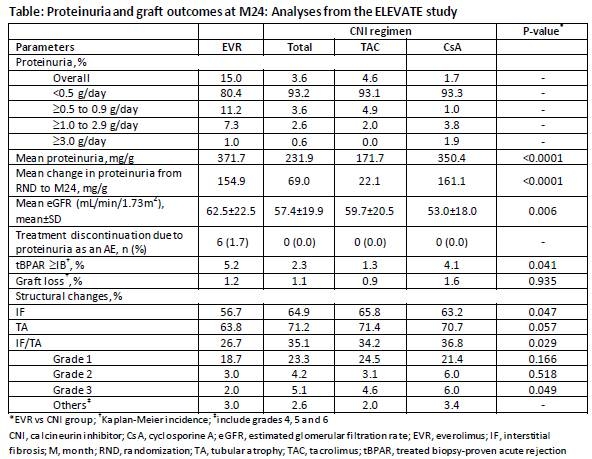Impact of Early Calcineurin Inhibitor Withdrawal on Renal Function and Urinary Protein Excretion: 24 Month Analyses of the ELEVATE Study.
1ELEVATE study group, Leiden, Netherlands
2Novartis, Basel, Switzerland
3Novartis Pharmaceutical Corporation, East Hanover, NJ.
Meeting: 2016 American Transplant Congress
Abstract number: 35
Keywords: Efficacy, Kidney transplantation, Proteinuria, Renal function
Session Information
Session Name: Concurrent Session: Kidney Transplant: CNI Minimization
Session Type: Concurrent Session
Date: Sunday, June 12, 2016
Session Time: 2:30pm-4:00pm
 Presentation Time: 2:42pm-2:54pm
Presentation Time: 2:42pm-2:54pm
Location: Room 311
Background: Proteinuria is a biomarker which helps in predicting graft outcomes in kidney transplant recipients (KTxRs). The ELEVATE study was designed to determine whether an early conversion from calcineurin inhibitor (CNI) to everolimus (EVR) improves renal function without compromising efficacy compared to standard CNI treatment in de novo KTxRs. Here we present the 24-month (M) estimated glomerular filtration rate (eGFR); incidence of proteinuria and other graft outcomes.
Methods: ELEVATE (NCT01114529) was a 24-month, multicenter, phase IIIb, open-label, controlled trial, in which 717 KTxRs were randomized (RND) at Week 10-14 post-Tx, to either convert to EVR (n=360; C0:6–10 ng/mL) or continue standard regimen (n=357; tacrolimus [TAC]-C0: 5–10 ng/mL; cyclosporine [CsA]-C0: 100–250 ng/mL)+enteric-coated mycophenolate sodium (1.08-1.44 g/day)+steroids. Renal function was assessed as eGFR (MDRD4 formula); incidence and severity of proteinuria as an adverse event (AE), and changes from RND to M24 were considered for analysis. Rates of treated biopsy-proven acute rejection [tBPAR], graft loss and structural changes (interstitial fibrosis [IF], tubular atrophy [TA] and IF/TA) at M24 post-Tx were considered as other graft outcomes.
Results: eGFR was better in EVR vs CNI group. The incidence of proteinuria as an AE and mean value at M24 including change from RND to M24 was higher in EVR vs CNI group. Only 1.0% and 0.6% of patients in EVR and CNI group, respectively reported proteinuria ≥3 g/day. Six patients discontinued treatment in EVR vs 0 in CNI group due to proteinuria as an AE. The incidence of tBPAR was numerically higher (non-significant) in EVR vs CNI group (mostly IA and IB). The overall incidence of graft loss was low and comparable between both groups. Incidence of IF/TA and IF was significantly lower in EVR vs CNI group (Table).
Conclusion: eGFR was better and despite more frequent with EVR, proteinuria was rarely a reason for treatment discontinuation.

CITATION INFORMATION: de Fijter J, Holdaas H, Seelen M, Sundar S, Bemelman F, Lopez P, Aguilar J, Bernhardt P, Wang Z, Cruzado J, van der Giet M. Impact of Early Calcineurin Inhibitor Withdrawal on Renal Function and Urinary Protein Excretion: 24 Month Analyses of the ELEVATE Study. Am J Transplant. 2016;16 (suppl 3).
To cite this abstract in AMA style:
Fijter Jde, Holdaas H, Seelen M, Sundar S, Bemelman F, Lopez P, Aguilar J, Bernhardt P, Wang Z, Cruzado J, Giet Mvander. Impact of Early Calcineurin Inhibitor Withdrawal on Renal Function and Urinary Protein Excretion: 24 Month Analyses of the ELEVATE Study. [abstract]. Am J Transplant. 2016; 16 (suppl 3). https://atcmeetingabstracts.com/abstract/impact-of-early-calcineurin-inhibitor-withdrawal-on-renal-function-and-urinary-protein-excretion-24-month-analyses-of-the-elevate-study/. Accessed December 19, 2025.« Back to 2016 American Transplant Congress
